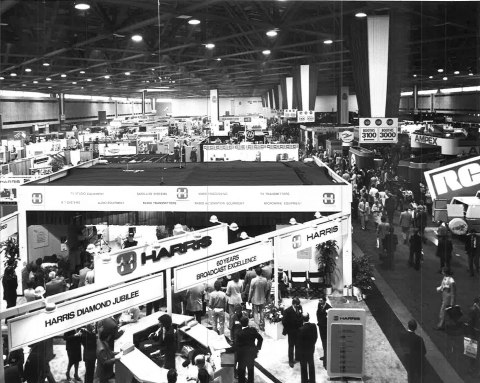The Future of Broadcasting is Alive and Well at NAB Show

The world of broadcasting has changed dramatically since the first National Association of Broadcasters (NAB) Convention at New York’s Commodore Hotel in October of 1923. Back then, “broadcasting” meant merely a limited number of AM radio stations and neither the NBC or CBS radio networks even existed yet.
Only 23 members attended that first meeting, where session topics included government regulation and “The Future of Broadcasting.”
NAB continued to hold a convention each year, although those during World War II were limited in size and scope. The only time it was canceled was in 1945 because of an appeal by the War Department to curtail non-essential travel by abandoning meetings of more than 50 people. But the 1946 convention bounced back and had about 3,000 attendees.
Exhibits were added at the 1941 Convention in St. Louis when NAB opened up associate memberships to equipment manufacturers. That year, 23 exhibitors showcased products to between 1,500 and 2,000 attendees. By the time things picked back up after the war, there were 45 exhibitors in 1946.
Although the name may refer to being a national association, NAB has long had an international focus. In 1947, the general counsel of the Canadian Association of Broadcasters was invited to speak, as was the Cuban vice-president of the Inter-American Broadcasters Association. Several hundred delegates from the International Telecommunications Conference (which was held in Atlantic City just prior to NAB) were invited to attend.
In 1951, the name was changed to the National Association of Radio and Television Broadcasters (NARTB), only to be changed back to NAB in 1958. President Dwight Eisenhower was the first of eight presidents to address the convention in 1955 in Washington, D.C.
During the 1950s and 60s, NAB primarily rotated between Chicago and Washington, D.C. But by 1977, attendance had grown so large that the event was spread over three D.C. hotels, with shuttles running between them. There was no convention center in the city yet, and hotel rooms were limited, so NAB moved to Las Vegas in 1978. For the next decade, the show alternated between Las Vegas and Dallas, until Vegas became its permanent home in 1991 with 51,000 attendees.
The NAB partnered with the Interactive Multimedia Association (IMA) in 1993 to introduce MultiMedia World, a conference and exhibition within the NAB Show, which was instrumental in expanding the show beyond traditional broadcasting into new content delivery platforms.
In 1997 attendance topped 100,000, which was double the number from only five years earlier. By 2000, exhibit space reached over a million net square feet.
In 2007, the brand changed to NAB Show Where Content Comes to Life. That concept was reinforced with the first live 3D broadcast from Los Angeles to the Las Vegas Convention Center, featuring Howie Mandel. Three years later, attendees were greeted live by astronauts aboard the International Space Station.
The 2016 show held in April hosted more than 103,000 attendees (26,893 of those representing 186 countries outside the U.S.) with 1,874 exhibitors covering 1,063,380 net square feet.
Some of the broadcasting milestones featured at NAB through the years include:
High-power AM broadcasting (mid- to late 1920s)
Cars equipped with radio sets (1931)
Television (late 1930s and early 1940s, with the post-WWII push to
introduce to the American public)
Videotape (this was the showstopper at the 1956 event)
Color television broadcasting (RCA introduced the color TV camera in 1960)
FM radio stereo broadcasting (1960s)
Satellite broadcasting (1961)
Ultra high frequency (UHF) television transmission (which paved the way
for today’s digital broadcasting)
Streaming video technology (1995)
High Definition Television (HDTV) broadcasting (1996)
Non-linear editing software (Apple’s Final Cut Pro introduced at the 1998
show)
Computer technology in broadcasting (paved the way for Internet content
creation and delivery).


Add new comment